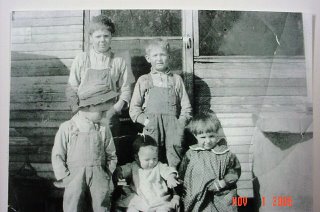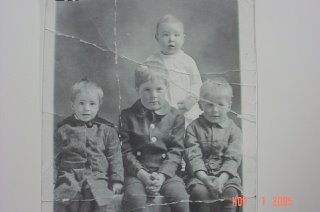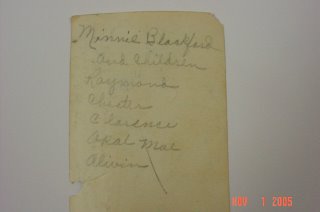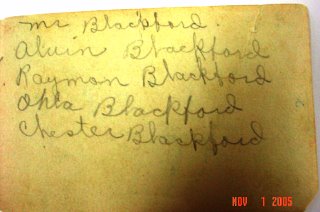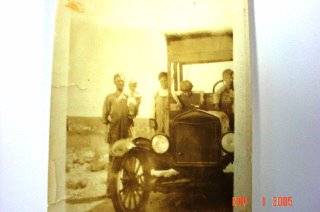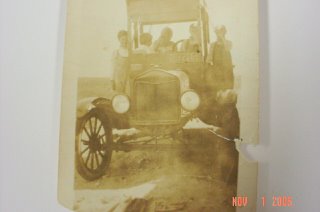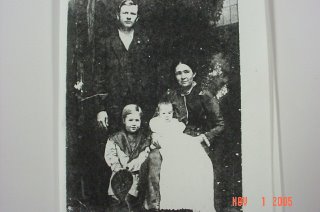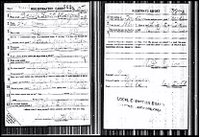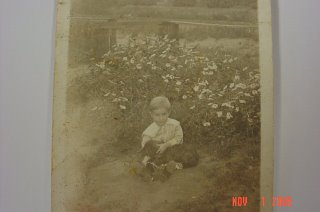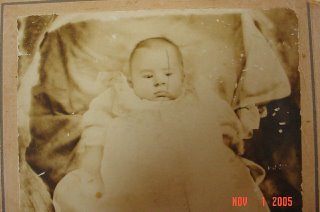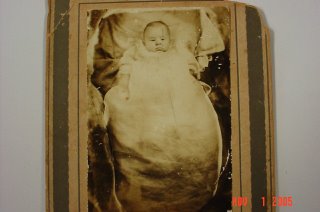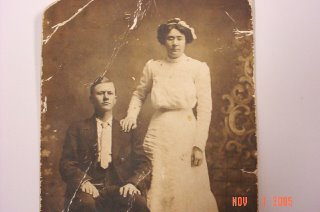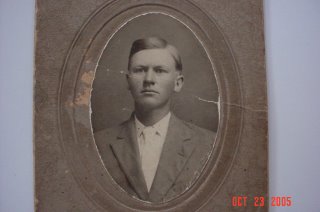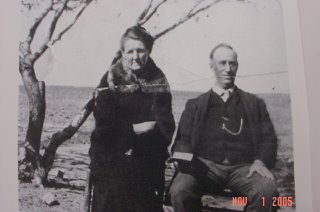Nathan Blackford
1869 - 1936
Nathan Blackford represents the generation furthest back of the Blackfords for which I have a picture. Born in Illinois, he married Nettie Mae West Smith in Ft. Smith, Arkansas. Their marriage resulted in only one son, Jessie Smith Blackford. Our cousin, Eunita, tells a wonderful family story about Nathan. She said he had gone to check on Jessie’s situation after Nettie’s and his marriage had ended. He found Jess was not being cared for in the manner he wanted for his son. As the story goes, he swooped Jess up onto his horse and rode away with him. Clearly that suited all involved because Jess lived with his father, step mother and their children thereafter. At age thirteen, Jess left that home, but that’s a story for later in these chronicles. So is the story of Nettie!
In the 1870 Census, Nathan is a two year old living with his parents William and Martha Jane in Mt. Erie, Wayne Co., Illinois. His father was farming and his real estate was valued at $1200 and his personal belongs, at $620. I would say they were financially comfortable but not wealthy. He had an older brother, William R. who was eleven, an older sister, Amelia J., ten, and twin younger siblings, Ada and Edward who were six months old.
The next hop takes us from Mt. Erie, Illinois to Spadra (near Clarksville) Arkansas. How the Blackfords traveled is not known to me, but I would assume covered wagon. It’s 522.62 miles from Mt. Erie, Illinois to Clarksville, Arkansas. I heard once that the covered wagons would cover about 12 miles per day. At that rate it would have taken the family 43 and a
half days to make that trip. So I guess if they started early one morning, about six weeks later, they would have arrived ….about noon. There were at least five children and maybe more by then. Can you imagine how many times Martha had to answer the question “Are we there yet?”
In the 1880 Census, Nathan was living with his parents William and Martha Jane in Spadra, Johnson Co., Arkansas, District 92. Nathan was eleven, but already he had an occupation listed, farming, the same as his father’s. The following is a brief history of the area in Arkansas where Nathan lived.
Brief History of Johnson County
A history of Johnson County by Lillian Mickel
Johnson County was created from a portion of Pope County, by the Act of November 16, 1833, and was named Johnson honoring the first Territorial Judge of Arkansas, Judge Benjamin Johnson. The Act creating the County, directed the temporary seat of justice should be held at the home of Elijah Alston, one of the pioneers of the County and whose home was at the Spadra Boat Landing.
In 1836 the County Seat was established here, after Mr. Josiah Cravens offered 1/4 mile square on Spadra Creek free to the Commissioners if they would locate the County Seat here. Clarksville was named honoring Lorenzo N. Clark another large land owner of the County, and one of the Commissioners who was chosen to locate the County Seat.
As early as 1828 there were a few white settlers here and still some Indians. The river boat landings at Spadra Bluff, Morrisons Bluff and Pittsburg Landings were the main river landings in our County. Those who came on barges, had to land at one or the other of these places. Numerous wagon trains from Tennessee, North Carolina, South Carolina, Georgia, and Kentucky brought many of our early settlers. They were all looking for good farm land and plenty of water.
Johnson County covers 700 square miles, there are five incorporated towns in our County, our population is 18,221 and Clarksville's population is 5,833. The first blind school in the state was organized here in Clarksville; also the first deaf-mute school was here in 1850. Clarksville was incorporated December 21, 1848. The College of the Ozarks originated in Cane Hill, Arkansas, Washington County in 1834, was chartered in 1852, then was moved to Clarksville in 1891.
Our first Spadra Creek Bridge was built in 1852, the same location has been used for every bridge that has been built ascending east hill, on east main street, as have the same locations been used for the Court House as the first one built in 1838, and every Methodist Church since the first one built in 1843, has been built in the same location. The College of the Ozarks School of Pharmacy in 1946 was the first in the State.
The first free delivery of rural mail in Arkansas was begun in Johnson County in 1896. We've had one or more banks in Clarksville since 1901. The first Educational Association organized in the State was organized in Clarksville, April 12, 1869, and was incorporated on February 23, 1881.
Many Indian signs can be found over the county. One called "the Rock House" is a cove of red sandstone. On the walls are many figures of turtles, lizards, and other reptiles. Other places too numerous to mention have turned up arrow heads and Indian relics.
There is no region of this state where the towering ranges of the Ozarks loom up more majestically. The Boston and Mulberry mountains traverse the northern areas of the county to the Arkansas River. The Mountains afford the widest and loveliest prospects it is possible to conceive.
This above information came from the following internet address:
http://www.oklahoma.net/~pvtspark/history.html
We are unable to determine where Nathan was living in 1890 because most of the 1890 records were destroyed by a fire at the Commerce Department in Washington, DC on 10 January 1921. The surviving fragments consists of 1,233 pages or pieces, including enumerations for Alabama, the District of Columbia, Georgia, Illinois, Minnesota, New Jersey, New York, North Carolina, Ohio, South Dakota, and Texas. The records o f only 6,160 of the 62,979,766 people enumerated survived the fire. The original 1890 census enumerated people differently than ever before that time. Each family was enumerated on a separate sheet of paper. 1890 was the only year this was done. [This information comes from Loretto Dennis Szucs and Sandra Hargreaves Luebking, eds. "Research in Census Records." The Source: A Guidebook of American Genealogy, rev. ed. Ancestry, Inc.: Salt Lake City, 1997.]
We do know, however, in 1891 he was married to Nettie in Pope County, Arkansas and that in 1892, Jessie Smith Blackford was born in Ft. Smith, Sebastian Co., Arkansas. Pope County is the county bordering Johnson County on the East side. So it seems Nathan and Nettie married near the area where Nathan had lived ten years earlier. It is interesting to note, however, that by the time Jessie was born, at least Nettie was living in Ft. Smith, Arkansas. The Ft. Smith City Birth Records from 1892 show no Blackford baby born, but a “Smith” without a first name. The site states, however, “Many local births were never recorded.” Ft. Smith is about sixty miles West from the area in which Nettie and Nathan were married. From many accounts, Ft. Smith was a
lot more exciting than rural Arkansas. The following is a thumbnail sketch from the Ft. Smith Museum of History site:
From the founding of the first Fort in 1817, through westward expansion, the Civil War and the Gay Nineties, the remarkable stories of this roaring frontier city are told in fascinating exhibits and programs. Fort Smith was the point of departure for pioneers, peacekeepers and outlaws by horse, steamboat and rail.
http://www.fortsmithmuseum.com/
At
www.fortsmith.org/ there is the following description of Ft. Smith:
Welcome to Fort Smith, Arkansas - an exciting travel destination that uniquely combines the history of the wild and wooly "Old West" with the gentle charm of the antebellum "Old South".
The
best site I found for getting a flavor of Ft. Smith is the “Ft. Smith Minutes – Sketches from the History of Ft. Smith” on the Ft. Smith National Historic Site (National Parks Service)
http://www.nps.gov/fosm/history/radio/index.htm
